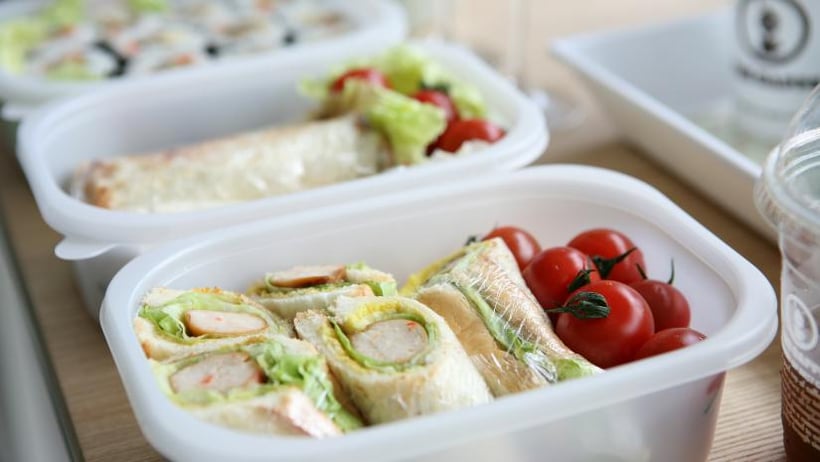
Many Canadians prepare their mid-day meal at home and bring it with them to work or school. This is a great way to save money, but it’s important to apply the same food safety rules to your packed lunch as you would to any other meal, and to take special precautions to keep packed lunches safe when you’re away from home.
Ditch the paper bag
Paper bags are fine if you’re eating peanut butter sandwiches every day, but if you want anything more substantial — e.g. leftover pasta, curry, sandwiches — you’re going to want a soft, insulated lunch bag or insulated lunch box.
Perishable foods, such as deli meat, cheese, cooked rice or pasta, need to be kept out of the Temperature Danger Zone (4°C – 60°C) to slow down the growth of bacteria that can cause food poisoning; insulated bags allow you to hold perishable foods at a safe temperature when refrigeration is not an option.
Start with safe food
A chilled lunch bag won’t save you from food poisoning if the food you’re putting in it is already contaminated with harmful bacteria, so make sure that you refrigerate perishable food items — also called high-risk foods — promptly.
For the times when you simply can’t keep high-risk foods out of the danger zone, either because you’re preparing them in your kitchen or transporting them home from the grocery store, remember that two hours is the maximum amount of time that high-risk foods can be left in this temperature range and still be considered safe to eat.
High-risk foods include (but are not limited to): meat, poultry, seafood, eggs and dairy products. Find out more about high-risk foods.
Keep cold foods cold
To keep lunches cold away from home, use an insulated lunch bag/box (as mentioned above) combined with at least two cold sources. Use frozen gel packs or combine a frozen gel pack with a frozen juice box or frozen bottle of water.
Place the cold sources on the top and bottom of your perishable food items inside the insulated bag. If there's a refrigerator available at your work or school, put your lunch in there once you arrive. If you want to keep your lunch inside the insulated bag while it's in the fridge, leave the lid open so that cold air can circulate and keep the food cold.
Not too hot on keeping foods cold? Pack these instead:
- peanut butter
- cookies, popcorn
- whole and dried fruits
- cereal, nuts, cereal bars
- bread, crackers, bagels
- unopened cans of meat and fish
Keep hot foods hot
If you’re packing a hot lunch (e.g. soup, stew, chili) use an insulated container to keep the food hot until lunchtime. Fill the container with boiling water, wait a few minutes, pour out the hot water and then pour your piping hot food in. Seal the container tightly and don’t open it until you’re ready to eat it, so you don't lose heat.
Reheat to perfection
If you’re lucky enough to have a microwave at your work or school, you won’t have to worry about keeping your hot food hot — provided you’re reheating your food to the appropriate temperature. As a general rule, all food should be reheated to 74°C or higher to destroy disease-causing bacteria like Salmonella or Campylobacter.
It’s a good idea to cover your food in the microwave to seal in moisture and give it a stir about halfway through to ensure the even distribution of heat (and to prevent the sides from drying out). Use a food thermometer to make sure your meal has reached the required temperature before eating. (If you don’t have one handy, make sure your food is steaming hot all the way through!)
Be allergy aware
As many as 1.2 million Canadians are affected by food allergies and that number is only increasing, especially among children. Any food can be an allergen, but the majority of allergic reactions in Canada are caused by peanuts, tree nuts, sesame seeds, soy, fish, shellfish, wheat, eggs, milk, mustard and sulphites.
Because of the potential seriousness of allergic reactions, many schools and some workplaces have banned certain allergens from entering the building. It’s important to follow the food allergen policies at your work or school, even if you — or your children — aren’t at risk. If there is anyone in the building who could suffer a life-threatening reaction to food that is brought in, you have a responsibility to follow the rules that have been put in place to keep them safe.
Is a restricted food item leaving you at a loss? Here are a few tips to help you follow the rules:
- Try allergen-free alternatives. For example, if peanut is a restricted food at your school or work, consider making sandwiches with almond, pumpkin or apple butter — or pack a protein-rich hummus instead.
- Always read food labels for every food item you pack in your lunch. Don't pack anything that contains a restricted ingredient and be wary of packaging with statements like “May Contain...”.
- If you're unsure if a packaged food item contains restricted food, call the manufacturer to find out.
For some people, even trace amounts of an allergen can cause a life-threatening allergic reaction.
Keep it clean
Before and after preparing packed lunches, wash your hands with soap and water for at least 20 seconds. Clean and sanitize cutting boards, dishes, utensils and countertops after preparing each food item and before you go on to the next item.
To prevent cross-contamination, use a separate cutting board for raw and cooked foods, or for foods that will not be cooked (e.g. don’t use the same cutting board for lettuce and tomatoes that you just used to cut raw meat or poultry.) After use, wash lunch bags with hot, soapy water and never reuse sandwich bags, foil or plastic wrap.





